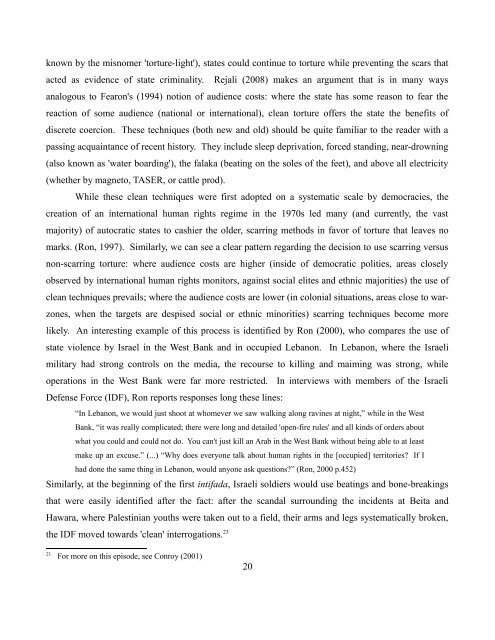The Torturer's Dilemma: Analyzing the Logic of Torture for Information
The Torturer's Dilemma: Analyzing the Logic of Torture for Information
The Torturer's Dilemma: Analyzing the Logic of Torture for Information
You also want an ePaper? Increase the reach of your titles
YUMPU automatically turns print PDFs into web optimized ePapers that Google loves.
known by <strong>the</strong> misnomer 'torture-light'), states could continue to torture while preventing <strong>the</strong> scars that<br />
acted as evidence <strong>of</strong> state criminality. Rejali (2008) makes an argument that is in many ways<br />
analogous to Fearon's (1994) notion <strong>of</strong> audience costs: where <strong>the</strong> state has some reason to fear <strong>the</strong><br />
reaction <strong>of</strong> some audience (national or international), clean torture <strong>of</strong>fers <strong>the</strong> state <strong>the</strong> benefits <strong>of</strong><br />
discrete coercion. <strong>The</strong>se techniques (both new and old) should be quite familiar to <strong>the</strong> reader with a<br />
passing acquaintance <strong>of</strong> recent history. <strong>The</strong>y include sleep deprivation, <strong>for</strong>ced standing, near-drowning<br />
(also known as 'water boarding'), <strong>the</strong> falaka (beating on <strong>the</strong> soles <strong>of</strong> <strong>the</strong> feet), and above all electricity<br />
(whe<strong>the</strong>r by magneto, TASER, or cattle prod).<br />
While <strong>the</strong>se clean techniques were first adopted on a systematic scale by democracies, <strong>the</strong><br />
creation <strong>of</strong> an international human rights regime in <strong>the</strong> 1970s led many (and currently, <strong>the</strong> vast<br />
majority) <strong>of</strong> autocratic states to cashier <strong>the</strong> older, scarring methods in favor <strong>of</strong> torture that leaves no<br />
marks. (Ron, 1997). Similarly, we can see a clear pattern regarding <strong>the</strong> decision to use scarring versus<br />
non-scarring torture: where audience costs are higher (inside <strong>of</strong> democratic polities, areas closely<br />
observed by international human rights monitors, against social elites and ethnic majorities) <strong>the</strong> use <strong>of</strong><br />
clean techniques prevails; where <strong>the</strong> audience costs are lower (in colonial situations, areas close to war-<br />
zones, when <strong>the</strong> targets are despised social or ethnic minorities) scarring techniques become more<br />
likely. An interesting example <strong>of</strong> this process is identified by Ron (2000), who compares <strong>the</strong> use <strong>of</strong><br />
state violence by Israel in <strong>the</strong> West Bank and in occupied Lebanon. In Lebanon, where <strong>the</strong> Israeli<br />
military had strong controls on <strong>the</strong> media, <strong>the</strong> recourse to killing and maiming was strong, while<br />
operations in <strong>the</strong> West Bank were far more restricted. In interviews with members <strong>of</strong> <strong>the</strong> Israeli<br />
Defense Force (IDF), Ron reports responses long <strong>the</strong>se lines:<br />
“In Lebanon, we would just shoot at whomever we saw walking along ravines at night,” while in <strong>the</strong> West<br />
Bank, “it was really complicated; <strong>the</strong>re were long and detailed 'open-fire rules' and all kinds <strong>of</strong> orders about<br />
what you could and could not do. You can't just kill an Arab in <strong>the</strong> West Bank without being able to at least<br />
make up an excuse.” (...) “Why does everyone talk about human rights in <strong>the</strong> [occupied] territories? If I<br />
had done <strong>the</strong> same thing in Lebanon, would anyone ask questions?” (Ron, 2000 p.452)<br />
Similarly, at <strong>the</strong> beginning <strong>of</strong> <strong>the</strong> first intifada, Israeli soldiers would use beatings and bone-breakings<br />
that were easily identified after <strong>the</strong> fact: after <strong>the</strong> scandal surrounding <strong>the</strong> incidents at Beita and<br />
Hawara, where Palestinian youths were taken out to a field, <strong>the</strong>ir arms and legs systematically broken,<br />
<strong>the</strong> IDF moved towards 'clean' interrogations. 23<br />
23 For more on this episode, see Conroy (2001)<br />
20
















